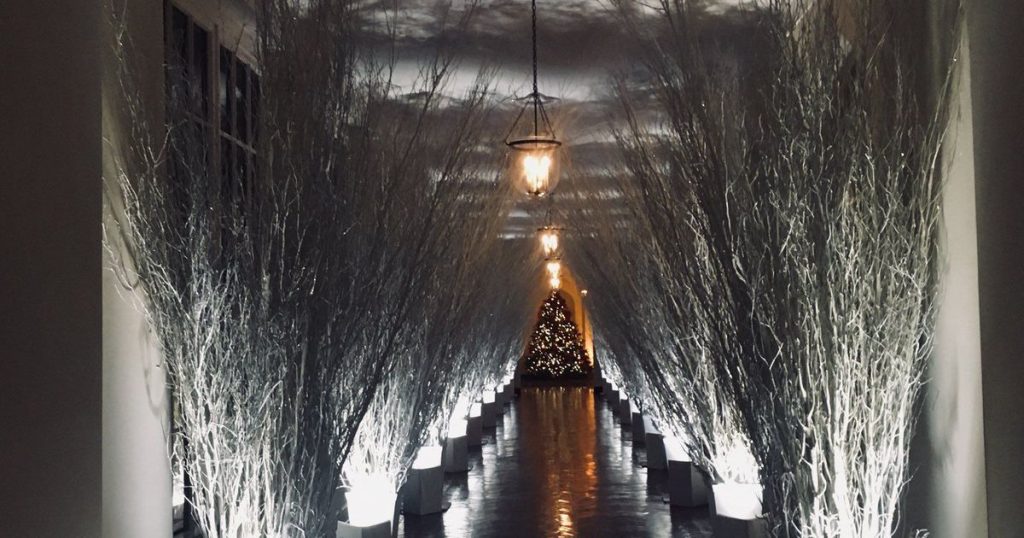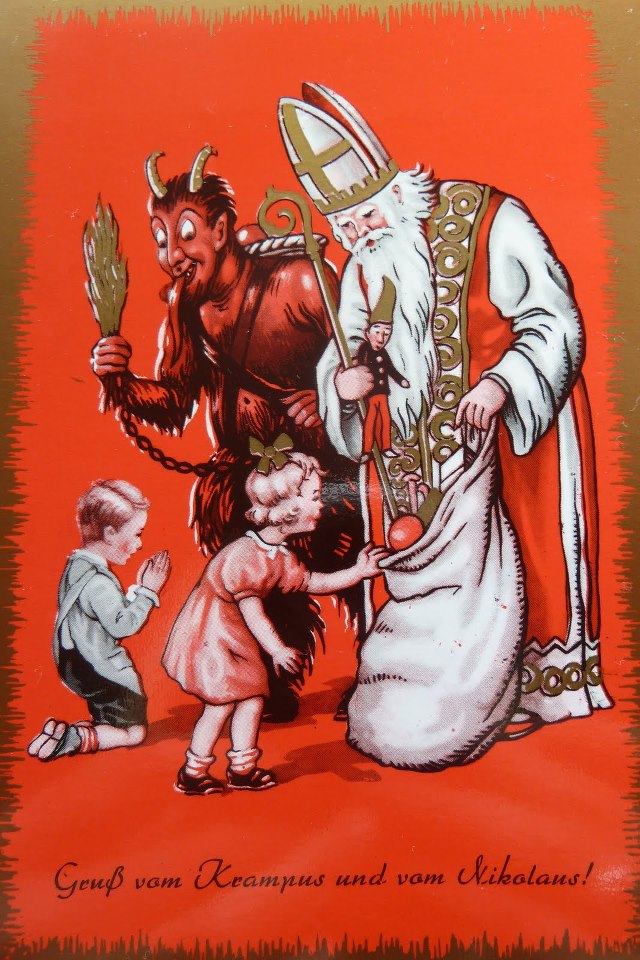The dark shall soon flee from the dells of the earth
So she a wonderful word to us speaks
The day shall again, new made rise from a rosy sky
Saint Lucy, Saint Lucy”
~ The Lucia Song: verse 3 (English Translation)
Recently, many left-leaning individuals in social media and news media had a field day mocking Melania Trump’s “creepy” White House Christmas decorations (well, really just one room). “Melania” then responded somewhat cryptically:
Do not question my hallway of great darkness. Christmas began as a pagan festival. I am simply returning to its roots. Some of us have not forgotten how to venerate the Old Gods.”

Now, regardless of the fact that it was not actually her that tweeted that, the false FLOTUS speaks truth in these words. Indeed, what we have come to know in the West as “Christmas”, with all the characters and symbols associated with it, was a largely European pagan festival that was not all about food, comfort, cheer, and gifts, but was also about the real tenuousness of life and the closeness of death for those in northern Eurasia during the winter months.
This festival was centered around the Solstice and the “Old Gods”. The primary figure in the Solstice drama was the Sun, represented among the Proto-Indo-Eurpoeans as the goddess, Sól (and among the later Europeans as Christ Jesus).
However, in addition to the Sun, there were other “actors” in the period of Yule; other forces of Nature and Creation that were central to the lives of the people who embodied this rich tradition. One of the most famous of these Old Gods happens to be one of the most famous (and in this consumerist culture, probably THE most famous) Christmas character of all – Santa Claus.
When it comes to the origins of the figure known as “Santa Claus”, a lot of people immediately gravitate toward the story of St. Nicholas of Myra. A somewhat legendary figure, St. Nicholas was reputed to have a “legendary habit” of secret gift-giving. Nicholas was a said to be a Greek Christian in the Byzantine Empire and during lived in the 4th Century A.D.- three to four centuries before the Muslim conquest of the region. However, some have argued that St. Nicholas was in fact born of wealthy ethnic Black Anatolian “Muurs”.
But the origins of what became Santa Claus are in truth much older than that, and originated in a much colder place. In many parts of pre-Christian Northern and Central Europe, the Winter Solstice was known as the time when Odin or Wotan – the white-bearded ruler of Asgard, led his hunting party across the sky. This event was known as “The Wild Hunt”, Odin rode his eight-legged (eight reindeer) steed named Sleipnir, which would leap great distances across the heavens. During this time, children would leave their boots by the chimney filled with carrots and hay to feed Sleipnir. In return for their charity, “Odin” would leave the children gifts by their boots.

This night of Odin’s “Wild Hunt” has a counterpart in what is known as Lussinatta, or “The Lussi Night” in Sweden. This is now celebrated as St. Lucy’s Day and occurs on the 13th of December every year. However, before the Gregorian Calendar shift, it would have fallen on December 21st– the night of the Winter Solstice.
Some legends suggest that a supernatural female entity was said to ride through the air with her fearsome followers called “Lussiferda” and that it was particularly dangerous to be out on this night. Misbehaved children had to take special care as Lussi could come down the chimney and take them away, and if certain tasks needed to prepare for Yule were not completed, Lussi would punish the household.

The contrast between Odin who left gifts and Lussi who brought punishment has echoes of the later pair of St. Nicholas/Santa Claus and the Krampus. Interestingly, some scholars link Krampus, as a member of the fearsome entourage of the ancient Germanic goddess Frau Perchta, who some connect with the ancient Norse goddess, Freya – one of the primary Vanir or old nature gods who some say ruled before the Aesir.
The inclusion of both the fearsome and the festive shows a deep understanding of the dualism inherent in nature that these ancient European peoples possessed – especially during this most perilous time of year. On the one hand, we have the often harsh and brutal forces of nature during the cold winter months. And on the other, we have the festive joy that comes from the promise of the return of the Sun.
But if we go even deeper and look at etymology and linguistics, we add another layer of sophistication. Swedish stems from the Indo-European family of languages, if we sound out the name of Lussi and in particular, her Lussiferda, the name “Lucifer” might perhaps come to mind. Lucifer, of course, stems from “lux ferre”, which in another Indo-European language, and that is Latin, literally means “light bringing”.
We perhaps see that these ancient Northern Europeans were pointing at how it was the oft-times terrifying darkness that carried the Light that brought life to the world. This is true not only within Nature, but within the trials and tribulations of our own lives and our own being- the night is darkest before the dawn. It is the darkness that brings the Light.
We see this deep understanding mirrored in in the Scandinavian Festival of St. Lucy where traditionally a procession is led by a beautiful young lady adorned with a crown or wreath of candles upon her head (although now this is being changed to be more “politically correct”), bringing the promise of life-giving Light into the darkest night.

The cold and brutal Northern European winter was a time that had the potential to bring starvation and death (and often did). But with after the passing of the Solstice, the people knew that the days were slowly beginning to grow longer, and the life-giving Sun was growing stronger.
The Norse-Germanic festival of Yule was celebrated from right around the time of the Winter Solstice all the way through the second week in January. This festival of feasting, drinking and sacrifice was a hallowed tradition among pre-Christian Northern European peoples to whom winter had a special significance that was not held among most others. Yule was the tradition of a people who were close to the land and intimately tied into the cycles and processes of Nature.
The industrious elves/dwarves, the holly, the mistletoe, and the evergreens that have all become symbols of “Christmas” are all hallmarks of the culture and lore of Northern Europe. The white of the pure, cleansing snow; the green of the evergreen tree – symbol of the magic of regenerative life; the red of the blood of the sacrifice and the folk; and the gold of the eternal undying Sun; these are the colors that are synonymous with “The Holidays”.
These wonderful things are the heritage of my people, our legacy and our contribution to the spiritual evolution of humanity. I am not one to cry “cultural appropriation” and do not take offense to others who find truth and power in the folk archetypes of my people.
However, it should also always be understood that the myths and folk archetypes of a people, are inseparable from the history and experience of that people. These archetypes of the Christmas season are inseparable from the unique folk consciousness and soul of the Indo-Aryan peoples- they are from us, and they are us.
Merry Christmas, Good Yule and WRA-ALDA’s Blessings.
Source Article from http://www.renegadetribune.com/odin-lucy-christmas-north/
 RSS Feed
RSS Feed















 December 12th, 2017
December 12th, 2017  Awake Goy
Awake Goy 
 Posted in
Posted in  Tags:
Tags: 













